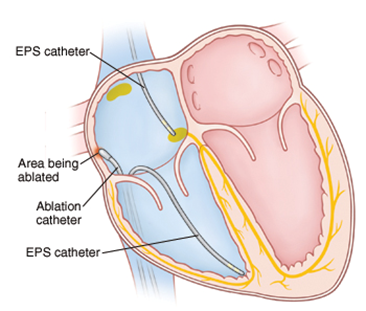Your Child’s Cardiac Ablation
What is an arrhythmia?
-
A normal heartbeat has a regular rate with an organized flow of electricity through the heart.
-
When a heart beats too fast, too slow, or in other ways that are not typical (irregular rate), this is an arrhythmia.
-
An arrhythmia can come from a main (focal) area in the heart or from an extra pathway.
-
Sometimes heart cells may alter the normal flow of the heart, causing arrhythmia.
-
Other times, electrical pathways that form before birth, after heart surgery, or with other heart conditions, change (disrupt) the normal flow of electricity. This causes an arrhythmia.
What is a cardiac ablation?
-
Cardiac ablation is a procedure that gets rid of abnormal cells and abnormal pathways. It will make the heart have a normal heart rhythm
-
An ablation can treat many types of arrhythmias. Ablation may make it possible for your child to stop long-term drug therapy.
-
Ablation can prevent more serious arrhythmias.
-
The Care Team will talk to your family about the risks and benefits of a cardiac ablation. Together, you and the team can decide if it is a good option for your child.
-
The success rate of cardiac ablation is very high. There is a small chance that the arrhythmia can come back.
What happens during a cardiac ablation?
-
An electrophysiologist (EP) - a doctor who specializes in diagnosing and treating heart rhythm disorders - will do the ablation on your child.
-
During the procedure, the doctor puts thin flexible wires (catheters) into the blood vessels through the groin and neck.
-
The catheters go through the vein up to the heart.
-
The doctor uses the catheter to stimulate, record, and map the heart’s electrical system. This test (electrophysiology study (EPS)) lets the team find the location of the cells causing the arrhythmia.
-
When the doctor finds those cells, they use the catheter to get rid of the abnormal cells (with heat or cold). This process is cardiac ablation.
-
Because your child needs to stay still for the procedure, The Care Team will give your child a special medicine (anesthesia) so they sleep through the procedure and do not feel the ablation.
-
The care team uses advanced imaging to get an exact three-dimensional (3D) map of your child’s heart. There is very little or no radiation during the procedure. This makes it much safer for your child.
-
The cardiac ablation takes about 4-6 hours to complete.

Where in the hospital does your child have a cardiac ablation?
-
You child will have the cardiac ablation in the electrophysiology lab.
-
In the lab, there is a special team of nurses, doctors, nurse practitioners and anesthesiologists who care for children when they have an ablation.
What happens after the cardiac ablation?
-
After the cardiac ablation, the care team will take your child to another unit until the anesthesia wears off.
-
Your child will need to lay flat for 2- 4 hours after the procedure. This prevents bleeding and swelling where the catheter enters the skin (insertion site).
-
A nurse will check the insertion site and monitor your child’s heart rate, heart rhythm, blood pressure and other vital signs while your child is laying flat.
-
There are no stitches at the insertion site. There is a band-aid.
When do you go home with your child?
What happens at home?
-
Most children can start their usual activities and go back to school within 72 hours of the procedure.
-
While there should not be any pain from the procedure, the groin may be sore or bruised for a few days.
-
Your child may need medications after the procedure. The Care Team will talk to you about giving your child medication for pain. You will also find information in your discharge instructions (both printed and on MyChart).
-
The Care Team will follow up with you after your child’s procedure.
Please call the Congenital Heart Center at 212-263-5940 if you have
any questions or concerns.
We are here for you.
Created in partnership with families and expertise from our Sala Institute for Child and Family Centered Care.
©2024 NYU Langone Health. All rights reserved. Reviewed for health literacy. This information is not intended as a substitute for professional medical care. Always follow your health care provider's instructions.